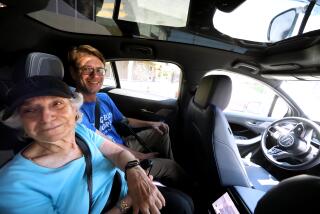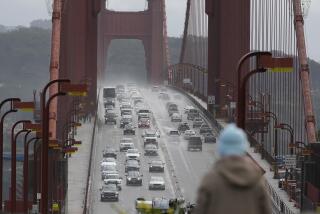Should future cars curb drunk drivers?
Those who think we’re already living in a nanny state probably aren’t going to like the nanny cars of the future.
Cars already sometimes behave like a nagging mom who’s seemingly more concerned about our safety than we are -- hence the dashboard beeping when you try to drive away without a seatbelt buckled, or the daytime running lights on some models that won’t shut off even if you want them to. But that’s nothing compared to what may be on the horizon: Cars that focus on belts rather than seatbelts, smelling your breath and blocking ignition if they sense you’re drunk.
The Senate version of the federal transportation bill calls for $24 million in additional funding over two years -- on top of the $10 million over five years already devoted to the program -- for research into alcohol-sensing technology in vehicles. The idea is to find out whether it would be feasible to demand that automakers include this technology as standard equipment in future cars. That’s a big departure from the way so-called interlock devices currently work. Some states require people convicted of drunk driving to have interlocks installed in their vehicles; they have to breathe into a tube, and if the device senses that their blood-alcohol level is over the legal limit (0.08%), their cars won’t start. California’s four largest counties, including Los Angeles, currently impose this penalty. But that only applies to known drunk drivers: The federal program might someday apply to everybody.
This does not please the restaurant industry. The American Beverage Institute, a restaurant trade association, objects that the devices will be set to detect alcohol at well below the legal limit, meaning if you down a glass or two of wine with dinner at a local eatery, you may have to call a cab to get home. Moreover, it says the devices will sometimes fail, meaning even a sober person will be unable to start his or her car. They’re legitimate points, but they shouldn’t stop the government from researching the idea.
First off, the whole point of the federal research program is to find a technology that is unobtrusive, making it a far cry from existing interlock systems -- which seem partially designed to humiliate those forced to install them because having a tube attached to one’s ignition signals to everybody who gets in the car that the driver has a drinking problem. The two most promising technologies under study are tissue spectrometry, which would use a touchpad and lasers to detect alcohol in human tissue, and distant spectrometry, in which sensors installed throughout the cabin could sniff a driver’s breath automatically every time he or she gets in the car (apparently, the sensors can be placed in such as way as to ensure it’s the driver’s breath they’re sniffing, not passengers’).
The beverage bunch seems to be correct that the devices would detect alcohol at below the legal limit. Sarah Ferguson, a leader of the joint venture between the Automotive Coalition for Traffic Safety and the National Highway Traffic Safety Administration that is directing research on the concept, concedes this point. In 2009, she told a columnist with the Milwaukee Journal Sentinel that the devices would be set with a safety margin because it’s better to “erroneously stop an innocent than to erroneously permit a drunk.” That’s worrisome. But I suspect that if the devices were set too far below the legal limit, they would cause popular outrage -- and the program would be too politically unpopular to ever be approved.
The ABI also complains that, under accepted failure-analysis modeling, the devices can be expected to be reliable only 99.99966% of the time -- which means that roughly 4,000 drivers in the U.S. per day would experience an ignition malfunction. In other words, it’s just one more electronic device that can go wrong, causing delays and inflating repair bills. Point taken.
There are other reasons to object. The devices would only detect alcohol use, meaning you could still smoke pot, drop acid or snort cocaine and get behind the wheel. That one’s pretty easy to dismiss: Drunk drivers kill orders of magnitude more people than stoned drivers. Meanwhile, statistics show the incidence of drunk driving is actually on the decline, so why take this step now? Also easy to dismiss: Because drunk drivers are implicated in nearly one-third of traffic deaths in the United States, killing roughly 11,000 people a year.
Conservatives will no doubt see the interlock research as another example of liberal interventionism, a government initiative to impose extra costs on consumers to protect them from themselves. But that’s pretty much the way they felt about Ralph Nader‘s pioneering investigations of automotive safety in the mid-1960s, which led to the creation of the NHTSA and such standard features as seatbelts -- and that worked out OK. Thanks largely to Nader, today’s cars are loaded with safety features designed to protect us from our own bad driving. If sensors can thwart drunk drivers in an unobtrusive way, they could save thousands of lives. And if the research shows that they fail at an unacceptable rate, or they catch too many drivers who aren’t legally drunk, they’re unlikely to attract the political support needed for approval. The restaurant industry is trying to quash the program before these questions are answered; I’d rather wait until the data are in to decide whether or not to reject the interlock concept.
RELATED:
Interlock devices: A sober idea for drivers
Senate OKs transportation bill with help for L.A. area
Drunk driving study: Car interlock devices reduce repeat offenses
Follow Dan Turner on Facebook
More to Read
A cure for the common opinion
Get thought-provoking perspectives with our weekly newsletter.
You may occasionally receive promotional content from the Los Angeles Times.










